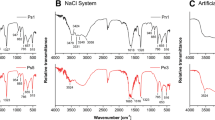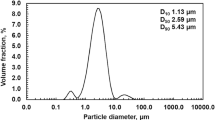Abstract
This paper reports on the investigation of experimental conditions relevant for spontaneous precipitation of significant amount of pure calcium oxalate dihydrate (COD). For this purpose, the hydrodynamic and thermodynamic parameters, such as mode of agitation, temperature, supersaturation and concentration of additives (citrate ions), have been studied. The results show that in the model systems, without the citrate addition and applied mechanical stirring, calcium oxalate monohydrate (COM) was observed as dominant modification after 20 min of aging, while the magnetic stirring resulted in a formation of a mixture of COM and calcium oxalate trihydrate (COT), regardless of the temperature applied. In the mechanically stirred systems, the addition of citrate ions in the range of concentrations, 0.001 mol dm−3 < c i (Na3C6H5O7) < 0.012 mol dm−3, caused the formation of COM and COD mixture at all temperatures. At the same conditions and in the magnetically stirred systems formation of COD, in a mixture with COT or COM, has been observed. The highest COD content in the mechanically stirred system was obtained at 45 °C and c i (Na3C6H5O7) = 0.001 mol dm−3 (w = 89.5%), while in the magnetically stirred system almost pure COD was obtained at 37 °C and c i (Na3C6H5O7) = 0.008 mol dm−3 (w = 96.5%).










Similar content being viewed by others
Notes
Occasionally, COD appeared as a typical weddellite, four-bladed dendritic form.
References
Hess B, Ryall RL, Kavanagh JP, Khan SR, Kok DJ, Rodgers AL, Tiselius HG (2001) Methods for measuring crystallization in urolithiasis research: why, how and when? Eur Urol 40(2):220–230
Bramley AS, Hounslow MJ, Ryall RL (1997) Aggregation during precipitation from solution. Kinetics for calcium oxalate monohydrate. Chem Eng Sci 52(5):747–757. doi:10.1016/S0009-2509(96)00447-2
Pitt K, Mitchell GP, Ray A, Heywood BR, Hounslow MJ (2012) Micro-mechanical model of calcium oxalate monohydrate aggregation in supersaturated solutions: effect of crystal form and seed concentration. J Cryst Growth 361:176–188. doi:10.1016/j.jcrysgro.2012.09.020
Conti C, Casati M, Colombo C, Realini M, Brambilla L, Zerbi G (2014) Phase transformation of calcium oxalate dihydrate-monohydrate: effects of relative humidity and new spectroscopic data. Spectrochim Acta Part A 128:413–419. doi:10.1016/j.saa.2014.02.182
Lj Brečević, Kralj D (1989) Factors influencing the distribution of hydrates in calcium oxalate precipitation. J Cryst Growth 97(2):460–468. doi:10.1016/0022-0248(89)90227-3
Brown P, Ackermann D, Finlayson B (1989) Calcium oxalate dihydrate (weddellite) precipitation. J Cryst Growth 98(3):285–292. doi:10.1016/0022-0248(89)90143-7
Škrtić D, Marković M, Komunjer LJ, Füredi-Milhofer H (1984) Precipitation of calcium oxalates from high ionic strength solutions: I. Kinetics of spontaneous precipitation of calcium oxalate trihydrate. J Cryst Growth 66(2):431–440. doi:10.1016/0022-0248(84)90227-6
Farmanesh S, Ramamoorthy S, Chung J, Asplin JR, Karande P, Rimer JD (2014) Specificity of growth inhibitors and their cooperative effects in calcium oxalate monohydrate crystallization. J Am Chem Soc 136(1):367–376. doi:10.1021/ja410623q
Heijnen W, Jellinghaus W, Klee WE (1985) Calcium oxalate trihydrate in urinary calculi. Urol Res 13(6):281–283. doi:10.1007/BF00262657
Schaefer A, Bausch W (1979) Bedeutung der Spurenelementverteilung in Calciumoxalat-Harnsteinen. Fortschr Urol Nephrol 14:236–241
Pak CY (1991) Citrate and renal calculi: new insights and future directions. Am J Kidney Dis 17(4):420–425. doi:10.1016/S0272-6386(12)80635-4
Hallson PC, Rose GA, Sulaiman S (1983) Raising urinary citrate lowers calcium oxalate and calcium phosphate crystal formation in whole urine. Urol Int 38(3):179–181. doi:10.1159/000280885
Ryall RL, Harnett RM, Marshall VR (1981) The effect of urine, pyrophosphate, citrate, magnesium and glycosaminoglycans on the growth and aggregation of calcium oxalate crystals in vitro. Clin Chim Acta 112(3):349–356. doi:10.1016/0009-8981(81)90458-7
Kok DJ, Papapoulos SE, Bijvoet OL (1986) Excessive crystal agglomeration with low citrate excretion in recurrent stone-formers. Lancet 1:1056–1058. doi:10.1016/S0140-6736(86)91329-2
Mattle D, Hess B (2005) Preventive treatment of nephrolithiasis with alkali citrate—a critical review. Urol Res 33(2):73–79. doi:10.1007/s00240-005-0464-8
Kok DJ, Papapoulos SE, Bijvoet OL (1990) Crystal agglomeration is a major element in calcium oxalate urinary stone formation. Kidney Int 37(1):51–56
Škrtić D, Füredi-Milhofer H, Marković M (1987) Precipitation of calcium oxalates from high ionic strength solutions: V. The influence of precipitation conditions and some additives on the nucleating phase. J Cryst Growth 80:113–120. doi:10.1016/0022-0248(87)90530-6
Lj Brečević, Kralj D (1986) The influence of some amino acids on calcium oxalate dihydrate transformation. J Cryst Growth 79:178–184. doi:10.1016/0022-0248(86)90433-1
Ackermann D, Brown P, Finlayson B (1988) COD production. Urol Res 16:219
Doherty WOS, Crees OL, Senogles E (1994) The preparation of calcium oxalate dihydrate crystals. Cryst Res Technol 29:517–524. doi:10.1002/crat.2170290412
Kaloustian J, El-Moselhy TF, Portugal H (2003) Determination of calcium oxalate (mono- and dihydrate) in mixtures with magnesium ammonium phosphate or uric acid: the use of simultaneous thermal analysis in urinary calculi. Clin Chim Acta 334:117–129
Echigo T, Kimata M, Kyono A, Shmizu M, Hatta T (2005) Re-investigation of the crystal structure of whewellite [Ca(C2O4)·H2O] and the dehydration mechanism of caoxite [Ca(C2O4)·3H2O]. Mineral Mag 69:77–88. doi:10.1180/0026461056910235
Babić-Ivančić V, Füredi-Milhofer H, Purgarić B, Brničević N, Despotović Z (1985) Precipitation of calcium oxalates from high ionic strength solutions III. The influence of reactant concentrations on the properties of the precipitates. J Cryst Growth 71:655–663. doi:10.1016/0022-0248(85)90374-4
Maurice-Estepa L, Levillain P, Lacour B, Daudon M (2000) Advantage of zero-crossing-point first-derivative spectrophotometry for the quantification of calcium oxalate crystalline phases by infrared spectrophotometry. Clin Chim Acta 298:1–11
Ouyang JM, Deng SP, Zhou N, Tieke B (2005) Effect of tartrates with various counterions on the precipitation of calcium oxalate in vesicle solutions. Colloids Surf A256:21–27. doi:10.1016/j.colsurfa.2004.09.035
Kok DJ, Papapoulos SE, Blomen LJ, Bijvoet OL (1988) Modulation of calcium oxalate monohydrate crystallization kinetics in vitro. Kidney Int 34(3):346–350
Ouyang JM (2006) Effect of temperature on growth and aggregation of calcium oxalate in presence of various carboxylic acids in silica gel systems. Mater Sci Eng C 26:679–682. doi:10.1016/j.msec.2005.06.060
Füredi-Milhofer H, Babić-Ivančić V, Lj Brečević, Filipović-Vinceković N, Kralj D, Lj Komunjer, Marković M, Škrtić D (1990) Factors influencing nucleation from solutions supersaturated to different crystal hydrates. Colloids Surf 48:219–230. doi:10.1016/0166-6622(90)80230-2
Thongboonkerd V, Semangoen T, Chutipongtanate S (2006) Factors determining types and morphologies of calcium oxalate crystals: molar concentrations, buffering, pH, stirring and temperature. Clin Chim Acta 367:120–131. doi:10.1016/j.cca.2005.11.033
Acknowledgements
This work was supported by the Department of Chemistry, University of Osijek, Croatia and Laboratory for Precipitation Processes, Ruđer Bošković Institute, Zagreb, Croatia. The authors thank Dr. B. Njegic Dzakula for help with calculations of solution composition and Dr. J. Kontrec for PSD analyses.
Author information
Authors and Affiliations
Corresponding authors
Ethics declarations
Conflict of interest
The authors declare that they have no conflict of interest.
Rights and permissions
About this article
Cite this article
Šter, A., Šafranko, S., Bilić, K. et al. The effect of hydrodynamic and thermodynamic factors and the addition of citric acid on the precipitation of calcium oxalate dihydrate. Urolithiasis 46, 243–256 (2018). https://doi.org/10.1007/s00240-017-0991-0
Received:
Accepted:
Published:
Issue Date:
DOI: https://doi.org/10.1007/s00240-017-0991-0




